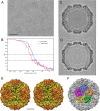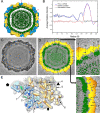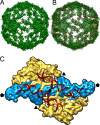The T=1 capsid protein of Penicillium chrysogenum virus is formed by a repeated helix-rich core indicative of gene duplication
- PMID: 20463071
- PMCID: PMC2898261
- DOI: 10.1128/JVI.00432-10
The T=1 capsid protein of Penicillium chrysogenum virus is formed by a repeated helix-rich core indicative of gene duplication
Abstract
Penicillium chrysogenum virus (PcV), a member of the Chrysoviridae family, is a double-stranded RNA (dsRNA) fungal virus with a multipartite genome, with each RNA molecule encapsidated in a separate particle. Chrysoviruses lack an extracellular route and are transmitted during sporogenesis and cell fusion. The PcV capsid, based on a T=1 lattice containing 60 subunits of the 982-amino-acid capsid protein, remains structurally undisturbed throughout the viral cycle, participates in genome metabolism, and isolates the virus genome from host defense mechanisms. Using three-dimensional cryoelectron microscopy, we determined the structure of the PcV virion at 8.0 A resolution. The capsid protein has a high content of rod-like densities characteristic of alpha-helices, forming a repeated alpha-helical core indicative of gene duplication. Whereas the PcV capsid protein has two motifs with the same fold, most dsRNA virus capsid subunits consist of dimers of a single protein with similar folds. The spatial arrangement of the alpha-helical core resembles that found in the capsid protein of the L-A virus, a fungal totivirus with an undivided genome, suggesting a conserved basic fold. The encapsidated genome is organized in concentric shells; whereas the inner dsRNA shells are well defined, the outermost layer is dense due to numerous interactions with the inner capsid surface, specifically, six interacting areas per monomer. The outermost genome layer is arranged in an icosahedral cage, sufficiently well ordered to allow for modeling of an A-form dsRNA. The genome ordering might constitute a framework for dsRNA transcription at the capsid interior and/or have a structural role for capsid stability.
Figures







Similar articles
-
Heterodimers as the Structural Unit of the T=1 Capsid of the Fungal Double-Stranded RNA Rosellinia necatrix Quadrivirus 1.J Virol. 2016 Nov 28;90(24):11220-11230. doi: 10.1128/JVI.01013-16. Print 2016 Dec 15. J Virol. 2016. PMID: 27707923 Free PMC article.
-
Chrysovirus structure: repeated helical core as evidence of gene duplication.Adv Virus Res. 2013;86:87-108. doi: 10.1016/B978-0-12-394315-6.00004-0. Adv Virus Res. 2013. PMID: 23498904 Review.
-
Three-dimensional structure of penicillium chrysogenum virus: a double-stranded RNA virus with a genuine T=1 capsid.J Mol Biol. 2003 Aug 8;331(2):417-31. doi: 10.1016/s0022-2836(03)00695-8. J Mol Biol. 2003. PMID: 12888349
-
Cryo-EM near-atomic structure of a dsRNA fungal virus shows ancient structural motifs preserved in the dsRNA viral lineage.Proc Natl Acad Sci U S A. 2014 May 27;111(21):7641-6. doi: 10.1073/pnas.1404330111. Epub 2014 May 12. Proc Natl Acad Sci U S A. 2014. PMID: 24821769 Free PMC article.
-
Capsid Structure of dsRNA Fungal Viruses.Viruses. 2018 Sep 7;10(9):481. doi: 10.3390/v10090481. Viruses. 2018. PMID: 30205532 Free PMC article. Review.
Cited by
-
Heterodimers as the Structural Unit of the T=1 Capsid of the Fungal Double-Stranded RNA Rosellinia necatrix Quadrivirus 1.J Virol. 2016 Nov 28;90(24):11220-11230. doi: 10.1128/JVI.01013-16. Print 2016 Dec 15. J Virol. 2016. PMID: 27707923 Free PMC article.
-
Initiation of RNA Polymerization and Polymerase Encapsidation by a Small dsRNA Virus.PLoS Pathog. 2016 Apr 14;12(4):e1005523. doi: 10.1371/journal.ppat.1005523. eCollection 2016 Apr. PLoS Pathog. 2016. PMID: 27078841 Free PMC article.
-
Double-stranded RNA virus outer shell assembly by bona fide domain-swapping.Nat Commun. 2017 Mar 13;8:14814. doi: 10.1038/ncomms14814. Nat Commun. 2017. PMID: 28287099 Free PMC article.
-
The infectious particle of insect-borne totivirus-like Omono River virus has raised ridges and lacks fibre complexes.Sci Rep. 2016 Sep 12;6:33170. doi: 10.1038/srep33170. Sci Rep. 2016. PMID: 27616740 Free PMC article.
-
Protruding Features of Viral Capsids Are Clustered on Icosahedral Great Circles.PLoS One. 2016 Apr 5;11(4):e0152319. doi: 10.1371/journal.pone.0152319. eCollection 2016. PLoS One. 2016. PMID: 27045511 Free PMC article.
References
-
- Abrescia, N. G., J. J. Cockburn, J. M. Grimes, G. C. Sutton, J. M. Diprose, S. J. Butcher, S. D. Fuller, C. San Martin, R. M. Burnett, D. I. Stuart, D. H. Bamford, and J. K. Bamford. 2004. Insights into assembly from structural analysis of bacteriophage PRD1. Nature 432:68-74. - PubMed
-
- Adamczak, R., A. Porollo, and J. Meller. 2005. Combining prediction of secondary structure and solvent accessibility in proteins. Proteins 59:467-475. - PubMed
-
- Agirrezabala, X., J. Martin-Benito, M. Valle, J. M. Gonzalez, A. Valencia, J. M. Valpuesta, and J. L. Carrascosa. 2005. Structure of the connector of bacteriophage T7 at 8A resolution: structural homologies of a basic component of a DNA translocating machinery. J. Mol. Biol. 347:895-902. - PubMed

